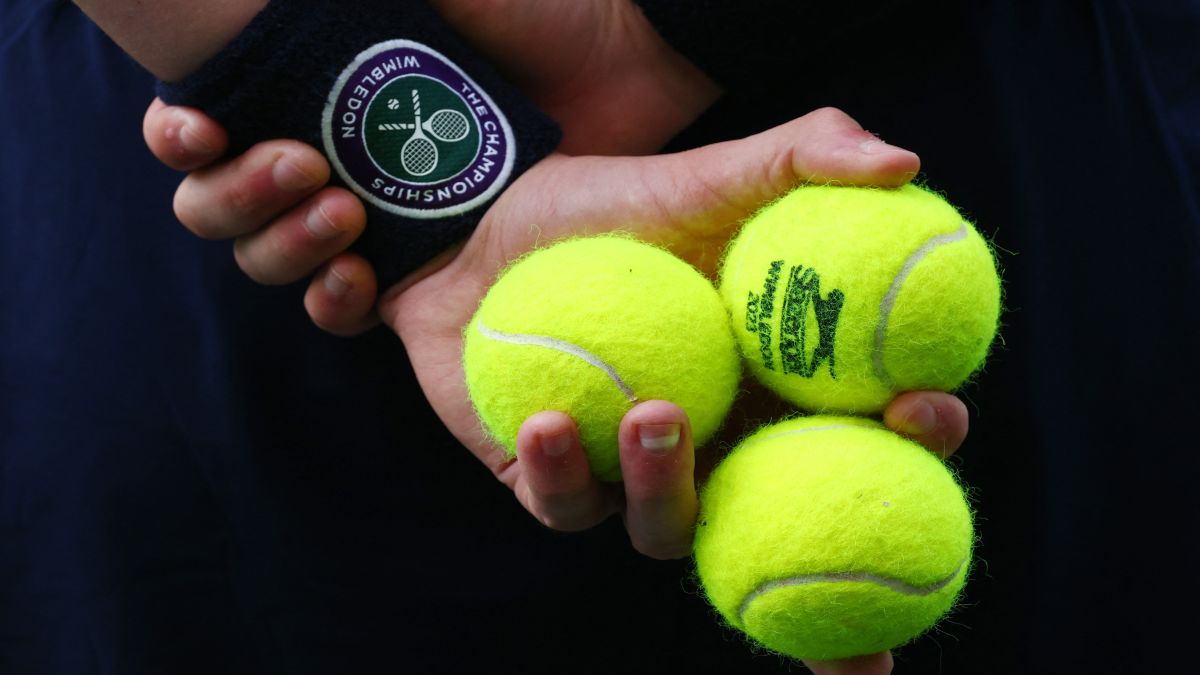The glorious Wimbledon 2024 championships are here — the event will run from July 1 to July 14. Many elements of this tennis tournament remain unchanged. However, there’s one little aspect that has changed — the tennis ball.
This small neon yellow orb is an integral part of the tournament and tennis, at large too. However, one will be surprised to know that the yellow ball wasn’t always this colour. And more surprisingly, it was David Attenborough, the British broadcaster and naturalist, who was responsible for this change.
Read on to find out about the history of the tennis ball, and
Wimbledon’s
rules for their use.
Initial tennis balls
As the game of tennis has developed and changed, so have the tennis balls. Before the creation of Lawn Tennis in the late 19th Century, its predecessor, Real Tennis, used balls made from leather stuffed with horse or dog hair or similar material such as wool.
After many iterations, which included cork, wood and other materials, in the late 1800s, lawn tennis began using rubber balls made by the Eagle India Rubber Company. To improve the quality and playing life of the rubber, the balls were covered with cloth before being filled with pressurised air.
Also read: Wimbledon 2024 to witness record prize money, an 11.9% increase from last year
At first, these rubber tennis balls were usually white or black, depending on the background colour of the courts.
Then came colour!
The change to the now-popular yellow ball is unique and interesting. In the mid-1960s, colour television started rolling out into viewers’ homes. In 1967, Sir David Attenborough, who is now famous for his Planet Earth series, was responsible for bringing colour to BBC2.
The 92-year-old naturalist told Radio Times: “We had been asking the government over and over again and they wouldn’t allow us, until suddenly they said, ‘Yes, OK, you can have it, and what’s more you’re going to have it in nine months’ time’.”
For this big change, he decided to focus on Wimbledon for the crowning moment. “I thought of Wimbledon. I mean, it is a wonderful plot: you’ve got drama, you’ve got everything. And it’s a national event, it’s got everything going for it,” he said to Radio Times. He also wanted to beat West Germany to full-colour broadcast ― the US and Japan had already done it by that time.
While broadcasting Wimbledon brought tennis to life, there was one problem. It made tracking the ball on screen difficult, especially when it fell near the white court lines.
After the Championships, Attenborough made a suggestion: a fluorescent yellow ball would be more visible on screen.
Realising the issue, the International Tennis Federation (ITF) carried out extensive research and finalised on fluorescent yellow after it was determined to be the most visible against the various surfaces used in tennis courts. In 1972, the ITF issued a rule change that stated all tournament balls would be white or yellow in colour.
Notably, the All England Lawn Tennis & Croquet Club waited until 1986 to make the transition to yellow. But as they say, the rest is history.
In recent times, there has even been a debate on the colour of the ball. While some say it’s yellow — the ITF calls it “optic yellow” — there are others who argue that it’s green.
It has also spurred many social media debates. In 2018, tennis GOAT Roger Federer was also asked what colour tennis balls are. “They’re yellow, right?” he had then said.
New balls, please
As with all things Wimbledon, there’s a lot of history tied to the tennis balls used at the event. Since 1902, the All England Club has used balls supplied by the Dunlop Slazenger Group. As per reports, the tournament uses over 55,000 balls for the event — 54,250 balls were used throughout the tournament in 2023.
But these balls have a long journey to make before arriving at the SW19. Reports say that the official Wimbledon ball flies between 11 countries and across four continents — a total of 81,384 km — before being manufactured in Bataan in the Philippines and then travelling to the UK for the event, according to research by the Warwick Business School.
As per the rules, the ball kids only have six balls in circulation at any time during a match. There are three balls per can, and the first two cans are in play for the first warmup and seven games of a match. Thereafter, the balls are changed every nine games.
Furthermore, to maintain their performance, the tennis balls are stored under lock and key before usage. Each ball is refrigerated around 20°C, providing optimal conditions for their performance during the intense matches.
Who’s enjoying Wimbledon? Here’s a fun fact: Wimbledon tennis balls are kept at 68 degrees Fahrenheit, as the temperature of the ball affects how it bounces. Wimbledon goes through more than 50,000 tennis balls each year. https://t.co/wiIHan1JC0 #Wimbledon #Tennis #FunFact pic.twitter.com/PeCqynqmjF
— Dancy Energy Consulting (@DancyEnergy) July 7, 2023
And here’s the coolest part of Wimbledon. Balls used in matches are retired to a store on the grounds and are sold to fans, with the proceeds going to charity. Andy Chevalier, Wimbledon’s ball distribution manager once told the Los Angeles Times: “I think it’s the best thing you can buy on the grounds. It’s brilliant.”
In the past, Wimbledon has donated balls to the UK Wildlife Trust, where they are repurposed as homes for harvest mice.
With inputs from agencies

)